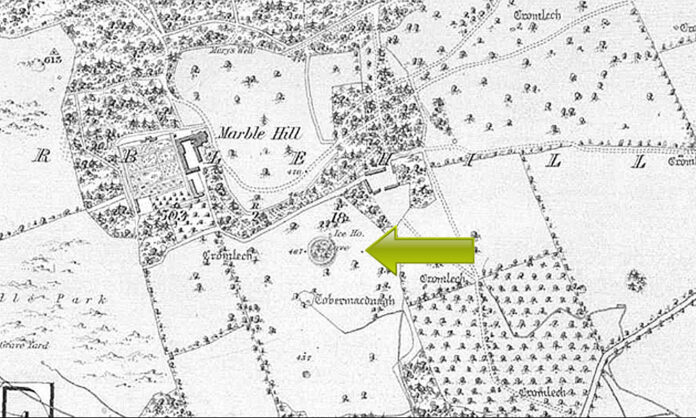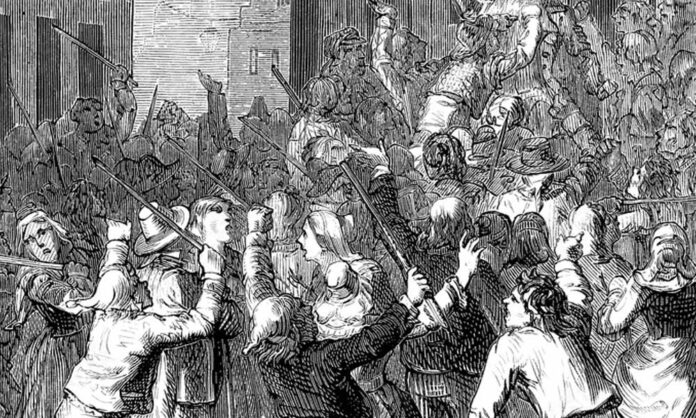Ancient Sites of Marblehill and Knockroe
This excerpt reprint from the Ordnance Survey Letters of Galway, written by T. O’Conor in November 1838, offers a glimpse into the fascinating archaeological heritage of County Galway, Ireland. Here, we discover two significant sites located near Marble Hill House:
- Giants’ Graves: The townland of Marble Hill boasts eight giant’s graves, intriguing megalithic structures likely used for burials in prehistoric times.
- Leaba Dhiarmada (Diarmad’s Bed): Situated one-mile northeast of Marblehill House in the townland of Knockroe lies a cave known as Leaba Dhiarmada, literally translating to “Diarmad’s Bed.” This site is described as a cave with a large stone covering it, potentially another ancient monument.
The letter also delves into the presence of cromlechs, often referred to as “Druids’ altars.” O’Conor describes several of these megalithic structures, some featuring simpler construction methods suggesting great antiquity, while others display more elaborate workmanship. These cromlechs typically consist of a large, flat capstone supported by upright stones. Notably, O’Conor highlights a “fine” example located within the demesne (lands) of Marble Hill itself. This particular cromlech, sadly damaged in the past, is comprised of a single stone measuring 30 feet long by 8 feet broad.
O’Conor expresses frustration at the destruction of such ancient sites, often at the hands of those unaware of their historical significance. He emphasizes the importance of preserving these “records of antiquity” for future generations.
The letter concludes with a mention of pillar stones, another type of megalith, and a reference to a specific example near Dunsandle. O’Conor acknowledges the lack of such structures in the immediate vicinity but notes local traditions attributing great age to the pillar stone on the Countess’s Hill.
This excerpt provides valuable insights into the rich archaeological landscape surrounding Marble Hill and the efforts to document these ancient sites in the 19th century. It serves as a reminder of the importance of preserving and understanding our past.
November 17th 1838. Ordnance Survey Letters of Galway
Ordnance Survey Letter of Galway
Giants graves, which are 8 in number, lie in the townland of Marble Hill; and Labadiarmad {Leaba Dhiarmad, i.e. Diarmad’s bed}, which is described in the Name book, (as) a cave with a stone over it, is situated in the townland of Knockroe, one mile N. East of Marble Hill House.
Dutton, in his Statistical Survey page 470, says that there are several Cromlechs†, or Druids’ altars, as they are frequently called; some of very rude workmanship, which shows their high antiquity, and others on which, more pains have been bestowed. Some are of one rude flag supported by equally rude pillars; in others the flag is upheld by side flags; they are uniformly destitute of any inscription, which plainly proves their erection at a very remote period.
There is a fine one in the demesne of Marble Hill, of one stone 30 feet long by eight feet broad; it was much injured by the hands of ignorance before the late Sir Thomas Burke became possessed of the estate, as many of the stones were taken for the purpose of building a common wall. It is strange the little interest many gentlemen take in the records of antiquity, as to permit them to be mutilated, or perhaps entirely demolished.
Sometimes, these Cromlechs are called Leabha Diarmuid is Grane, or from some whimsical allusion, Darby and Grane’s bed. There can be little doubt they were used for some religious ceremony of the Druids, and in after-times, might have been imitated or used for places of sepulture, but they are so different in their form and workmanship as not to be mistaken. I do not recollect to have seen any of those pillar stones that are reckoned of such high antiquity, but that on the Countess’s hill near Dunsandle; tradition says it is of a very remote period & co.
†’Grose says the derivation of Cromlech is from the Armoric word Crum, crooked and leh, a stone.’ – {Note at the end of p. 470.}
Your obedient Servant,
T. O’Conor
November 17th 1838. Ordnance Survey Letters of Galway




